Programming Project #1: Turtle Graphics Interpreter
Programming Project #1: Turtle Graphics Interpreter
Programming Project #1: Turtle Graphics Interpreter
You also want an ePaper? Increase the reach of your titles
YUMPU automatically turns print PDFs into web optimized ePapers that Google loves.
<strong>Programming</strong> <strong>Project</strong> <strong>#1</strong>: <strong>Turtle</strong> <strong>Graphics</strong> <strong>Interpreter</strong><br />
CS 355<br />
Due 11:59 pm Tuesday, February 8, 2011<br />
1 Introduction<br />
For this programming project, you will create a simple interpreter (using a recursive descent parsing strategy)<br />
for the <strong>Turtle</strong> <strong>Programming</strong> Language described in Section 2. Your interpreter will build an abstract syntax<br />
tree (AST) for each top-level statement and “execute” this tree “on the fly.” The program will read the<br />
input source code from standard input and write a Portable Gray Map (PGM) image to standard output.<br />
This image contains the line drawing specified by the input program.<br />
2 High Level <strong>Turtle</strong> Language<br />
An unambiguous, non-left-recursive grammar for our high-level turtle language is given in Figure 1. Curly<br />
braces {} and square brackets [] are used as meta-symbols as described in the caption to make the grammar<br />
more compact (they also hint at iteration and branching respectively in the corresponding recursive descent<br />
subroutines). The terminals (i.e., tokens) of the languages are +, -, *, /, (, ), =, , and the multicharacter<br />
tokens are listed in Table 1, and the reserved words are given in Table 2. The remainder of a line<br />
is ignored following a # which allows the programmer to insert comments into the source code.<br />
token regular expression<br />
IDENT [a-zA-Z\_][a-zA-Z0-9\_]*<br />
REAL [0-9]+([\.][0-9]*)?<br />
ASSIGN :=<br />
NE <br />
LE =<br />
Table 1: Multi-character tokens.<br />
OR AND NOT WHILE<br />
DO OD IF THEN<br />
ELSIF ELSE FI HOME<br />
PENDOWN PENUP FORWARD RIGHT<br />
LEFT PUSHSTATE POPSTATE<br />
Table 2: Reserved words.<br />
Figure 2 lists a simple program for drawing an N side polygon. Note that our language is case sensitive<br />
and reserved words are always in upper case. Variables (i.e., user defined identifiers) are used to hold floating<br />
point numbers and are never declared, but “pop” into existence the first time they are referenced and are<br />
initialized with a value of zero.<br />
1
program → stmt seq $ (1)<br />
stmt seq → stmt {stmt} (2)<br />
stmt → assign | while stmt | if stmt | action (3)<br />
assign → IDENT ASSIGN expr (4)<br />
block → stmt {stmt} (5)<br />
while stmt → WHILE bool DO block OD (6)<br />
if stmt → IF bool THEN block {ELSIF bool THEN block} [ELSE block] FI (7)<br />
action → HOME | PENUP | PENDOWN | FORWARD expr (8)<br />
→ LEFT expr | RIGHT expr | PUSHSTATE | POPSTATE (9)<br />
expr → term {+ term | − term} (10)<br />
term → factor {∗ factor | / factor} (11)<br />
factor → − factor | + factor | ( expr ) | IDENT | REAL (12)<br />
bool → bool term {OR bool term} (13)<br />
bool term → bool factor {AND bool factor} (14)<br />
bool factor → NOT bool factor | ( bool ) | cmp (15)<br />
cmp → expr cmp op expr (16)<br />
cmp op → = | NE | < | LE | > | GE (17)<br />
Figure 1: Grammar for turtle graphics language. {α} specifies that α can occur zero or more times and<br />
[α] denotes that α is optional. The $ in the first production indicates that there should be no more tokens<br />
following stmt seq. Production 2 represents a sequence of top-level statements, whereas Production 5 denotes<br />
a list of statements nested inside another statement construct.<br />
N := 5<br />
L := 10<br />
THETA := 360 / N<br />
PENDOWN<br />
I := 1<br />
WHILE I
3 Lexical analysis<br />
You will be provided with the C source code for a scanner that returns the next token in the input stream<br />
read from stdin:<br />
enum { /* non-single char tokens */<br />
IDENT_ = 256, ASSIGN_, REAL_, NE_, LE_, GE_, OR_, AND_, NOT_,<br />
WHILE_, DO_, OD_, IF_, THEN_, ELSIF_, ELSE_, FI_,<br />
HOME_, PENUP_, PENDOWN_, FORWARD_, RIGHT_, LEFT_, PUSHSTATE_, POPSTATE_<br />
};<br />
typedef union { /* lexeme associated with certain tokens */<br />
float f; /* REAL_ */<br />
char *s; /* IDENT_ */<br />
} LVAL;<br />
extern int lineno; /* current source code line number */<br />
/*<br />
* Returns the next token/lexeme read from stdin.<br />
* Returns 0 when there are no more tokens.<br />
*/<br />
int nextToken(LVAL *lval);<br />
Tokens are encoded as int’s via the enum shown above (single character tokens are encoded with their ASCII<br />
value) and lval represents the lexeme associated with the token.<br />
4 Symbol Table<br />
Since all variables are global and represent floating point numbers we can simply represent a symbol table as<br />
a linked list where each node holds the identifier string (i.e., the symbol) and its associated value. Variables<br />
are not declared and they “pop into existence” when they are first referenced (they initially hold the value<br />
0). Variables are updated via assignment statements and can be referenced in expressions.<br />
5 Recursive descent parsing and on-the-fly execution<br />
The grammar in Figure 1 is designed for a fairly straight forward implementation of a recursive descent<br />
parser as described in class. There is one recursive subroutine for each non-terminal in the grammar. The<br />
right hand side (RHS) of the corresponding productions dictate the body of each subroutine: non-terminals<br />
on the RHS map to (possibly recursive) subroutine calls; terminal symbols have to be “matched.” When<br />
there are multiple rewrite rules for a non-terminal, deciding which procedure to call is determined using via<br />
a single “look-ahead” token. Since program is the start symbol, we begin parsing by fetching the first token<br />
and calling program() (shown in Figure 3) which starts the parsing process. Using the first production as<br />
a guide, program() invokes stmt seq() which parses and executes each top-level statement.<br />
5.1 Abstract Syntax Trees<br />
The interpreter proceeds by building an abstract syntax tree (AST) for each top-level statement and then<br />
executing it as shown by the code in Figure 4. In this case, there are two flavors of syntax trees: statement<br />
trees and expression trees.<br />
3
int lookahead; /* next token */<br />
LVAL lval; /* value associated with token */<br />
...<br />
void program(void) {<br />
stmt_seq();<br />
if (lookahead != 0) syntax_error("Extraneous input!");<br />
}<br />
...<br />
int main(void) {<br />
...<br />
lookahead = nextToken(&lval);<br />
program();<br />
...<br />
return 0;<br />
}<br />
Figure 3: Parsing is initiated in main() by reading the first look-ahead token and calling the subroutine<br />
program() associated with the start symbol program.<br />
void stmt_seq(void) {<br />
do {<br />
Stmt *s = stmt(); /* build syntax for next statment */<br />
executeStmt(s); /* execute syntax tree */<br />
destroyStmt(s); /* delete syntax since it is no longer needed */<br />
} while (stmtPrefix()); /* keep looping as long as there are more statements */<br />
}<br />
Figure 4: Using Production 2 from the grammar in Figure 1 as our guide, this routine fetches and executes<br />
each top-level syntax tree. The stmtPrefix() function returns true when the lookahead token is a prefix<br />
for another statement (i.e., is IDENT , WHILE , IF , etc. . . ).<br />
4
5.1.1 Statement Trees<br />
A statement tree represents a program statement that can be executed and an expression tree denotes an<br />
arithmetic or boolean expression that can be evaluated. The structure of each tree depends on the specific<br />
statement our expression it represents. Figure 5 shows five different kinds of statement trees. What each<br />
statement tree has in common with the others is that that it can be executed; Therefore we would like to<br />
represent all statement trees using a single data type named Stmt. In Figure 6 we use the “old-school”<br />
technique for encoding multiple data structures into one using C’s union mechanism. A more modern<br />
object-oriented technique would create an abstract base class for all statement trees and use inheritance to<br />
represent specific trees. Figure 7 shows how we might organize our class hierarchy in C++.<br />
ASSIGN_STMT<br />
WHILE_STMT<br />
BLOCK_STMT<br />
lvalue<br />
(symbol table<br />
reference)<br />
rvalue<br />
(expression<br />
tree)<br />
condition<br />
(expression<br />
tree)<br />
body<br />
(statement<br />
tree)<br />
list<br />
(list of<br />
statement trees)<br />
IF_STMT<br />
ACTION_STMT<br />
condition<br />
(expression<br />
tree)<br />
then_body<br />
(statement<br />
tree)<br />
else_body type<br />
(statement tree, (PENUP,<br />
may be NULL) PENDOWN,<br />
FORWARD,...)<br />
argument<br />
(expression tree,<br />
may be NULL)<br />
Figure 5: Different kinds of statement trees.<br />
5.1.2 Expression Trees<br />
An expression tree represents an expression that can be evaluated – in our case all expressions evaluate to a<br />
floating point number (boolean expressions evaluate to zero (false) or non-zero (true)). Figure 8 shows how<br />
we might encode all the various types of expression trees using the single type named Expr (again this can<br />
be done more elegantly using object-oriented techniques). Figure 9 mimics Production 10 from the grammar<br />
in Figure 1 to parse arithmetic expressions.<br />
6 What to submit<br />
You will be provided with C source code for the scanner and turtle graphics functions along with some test<br />
input programs. Please test your code thoroughly before submission. Implement all grammar constructs<br />
except for the if stmt which is left as extra credit. Useful error message concerning lexical or syntax errors<br />
(along with a graceful exit with a non-zero status code) are required.<br />
You will create an archive file (as described on the course electronic submission page) that contains the<br />
following:<br />
• A text file named README that contains the following:<br />
– Author(s) and contact information (email address(es));<br />
– Brief overview of the project;<br />
– <strong>Project</strong> datestamp, version number, modification history, and any other useful status information.<br />
– List of instructions necessary for compiling, linking, and executing your program;<br />
– List of all files in the archive.<br />
5
typedef struct Stmt {<br />
int type; /* ASSIGN_STMT, WHILE_STMT, BLOCK_STMT, etc... */<br />
union {<br />
struct {SymTab *lval; Expr *rval;} assign_;<br />
struct {Expr *cond; struct Stmt *body;} while_;<br />
struct {struct Stmt *list;} block_;<br />
...<br />
} s;<br />
struct Stmt *next; /* link-list field used by block statements */<br />
} Stmt;<br />
void executeStmt(Stmt *stmt) { /* executes a statement tree */<br />
switch(stmt->type) {<br />
case ASSIGN_STMT:<br />
stmt->s.assign_.lval->val = evalExpr(stmt->s.assign_.rval);<br />
break;<br />
case WHILE_STMT:<br />
while (evalExpr(stmt->s.while_.cond) != 0)<br />
executeStmt(stmt->s.while_.body);<br />
break;<br />
...<br />
}<br />
}<br />
Figure 6: Stmt data type that uses a C union to encode multiple statement tree structures as one data type.<br />
The executeStmt() function “executes” any given statement tree.<br />
6
class Stmt { // Abstract base class for statement trees<br />
public:<br />
virtual void execute() const = 0; // virtual method for executing statement<br />
virtual ~Stmt() {}<br />
// virtual desctructor<br />
};<br />
class Assign : public Stmt { // statement tree for assignment<br />
Symbol *lvalue; // symbol table entry referencing variable’s value<br />
Expr *rvalue; // expression tree for right side of assignment<br />
public:<br />
Assign(const char ident, Expr *expr) : lvalue(symtab.lookup(ident)), rvalue(expr) {}<br />
virtual void execute() const {lvalue->val = expr->evaluate();}<br />
virtual ~Assign() {delete rvalue;}<br />
};<br />
class While : public Stmt { // statement tree for while loops<br />
Expr *cond; // expression tree for condition<br />
Stmt *body; // statement tree (block statement) for loop body<br />
public:<br />
While(Expr *c, Stmt *b) : cond(c), body(b) {}<br />
virtual void execute() const {while (cond->evaluate() != 0) body->execute();}<br />
virtual ~While() {delete cond; delete body;}<br />
};<br />
Figure 7: Deriving statement trees from the abstract base class Stmt in C++.<br />
typedef struct Expr {<br />
int type; /* NUM_EXPR, VAR_EXPR, ADD_EXPR, ... */<br />
union {<br />
float num; /* NUM_EXPR */<br />
SymTab *sym; /* VAR_EXPR */<br />
struct Expr *unary; /* unary operation (NEG_EXPR, ...) */<br />
struct {struct Expr *left, *right;} binary; /* binary operation (ADD_EXPR,...) */<br />
} op;<br />
} Expr;<br />
float evalExpr(Expr *expr) { /* evaluate and expression tree */<br />
switch(expr->type) {<br />
case NUM_EXPR: return expr->op.num;<br />
case VAR_EXPR: return expr->op.sym->val;<br />
case ADD_EXPR: return evalExpr(expr->op.binary.left) +<br />
evalExpr(expr->op.binary.right);<br />
...<br />
}<br />
}<br />
Figure 8: Expression tree data type and function for evaluating them.<br />
7
Expr *expr(void) {<br />
Expr *e = term();<br />
while(1) {<br />
if (lookahead == ’+’) {<br />
match(’+’);<br />
e = createBinaryExpr(ADD_EXPR, e, term());<br />
} else if (lookahead == ’-’) {<br />
match(’-’);<br />
e = createBinaryExpr(SUB_EXPR, e, term());<br />
} else {<br />
break;<br />
}<br />
}<br />
return e;<br />
}<br />
Figure 9: Recursive descent function for parsing arithmetic expressions.<br />
This file is intended to communicate to the uninitiated what the project is about and how to build<br />
and use the resulting executable. It should neither include implementation details nor meaningless<br />
terminology and useless references to course material.<br />
• All source code.<br />
• A Makefile for building program.<br />
• Any pertinent test files.<br />
You will submit your project electronically as described on the class web site. It is due at midnight on the<br />
due date.<br />
8


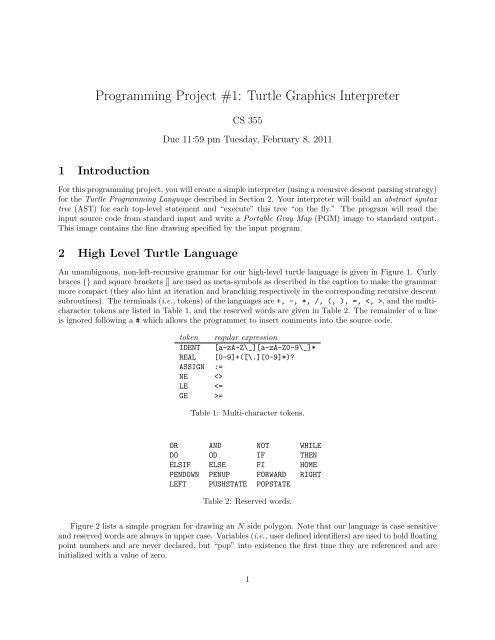
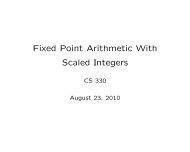
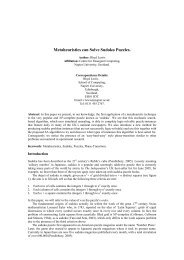
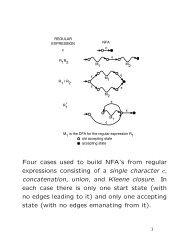
![[PDF] Fun with Syntax - ezekiel](https://img.yumpu.com/48148851/1/190x245/pdf-fun-with-syntax-ezekiel.jpg?quality=85)
![[PDF] Syntax and Semantics](https://img.yumpu.com/40036635/1/190x245/pdf-syntax-and-semantics.jpg?quality=85)

![[PDF] Turtle Graphics - ezekiel](https://img.yumpu.com/30626918/1/190x245/pdf-turtle-graphics-ezekiel.jpg?quality=85)
![[PDF] Intro to OpenGL and GLUT programming](https://img.yumpu.com/30459270/1/190x146/pdf-intro-to-opengl-and-glut-programming.jpg?quality=85)
![[PDF] CFL Pumping Lemma](https://img.yumpu.com/29995553/1/190x245/pdf-cfl-pumping-lemma.jpg?quality=85)

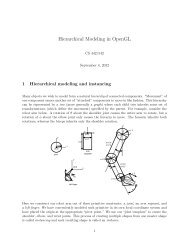
![[PDF] Encapsulation + Inheritance + Polymorphism](https://img.yumpu.com/24621947/1/190x245/pdf-encapsulation-inheritance-polymorphism.jpg?quality=85)